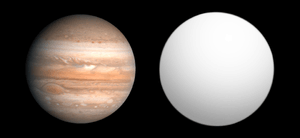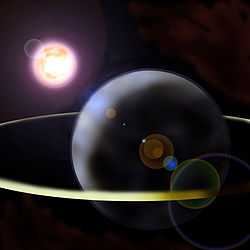WASP-11b/HAT-P-10b
| Extrasolar planet | List of extrasolar planets | |
|---|---|---|
 | ||
| Parent star | ||
| Star | WASP-11/HAT-P-10[1] | |
| Constellation | Perseus | |
| Right ascension | (α) | 03h 09m 28.55s[2] |
| Declination | (δ) | +30° 40′ 24.9″[2] |
| Apparent magnitude | (mV) | 11.89 |
| Distance | 408+20 −16[2] ly (125+6 −5[2] pc) | |
| Spectral type | K3V[3] | |
| Orbital elements | ||
| Semimajor axis | (a) | 0.0439+0.0006 −0.0009[2] AU |
| Eccentricity | (e) | 0[2] |
| Orbital period | (P) | 3.7224690 ± 0.0000067[2] d |
| Inclination | (i) | 88.5 ± 0.6[2]° |
| Time of transit | (Tt) | 2454729.90631 ± 0.00030[2] JD |
| Semi-amplitude | (K) | 69.1 ± 3.5[2] m/s |
| Physical characteristics | ||
| Mass | (m) | 0.460 ± 0.028[2] MJ |
| Radius | (r) | 1.045+0.050 −0.033[2] RJ |
| Density | (ρ) | 498 ± 64[2] kg m−3 |
| Surface gravity | (g) | 10.5[2] m/s² |
| Temperature | (T) | 1030+26 −19[2][note 1] |
| Discovery information | ||
| Discovery date | April 1, 2008 (announced) September 26, 2008 (preprints) | |
| Discoverer(s) | West et al. (SuperWASP) Bakos et al. (HATNet) | |
| Discovery method | Transit | |
| Discovery site | SAAO | |
| Discovery status | Independently confirmed | |
| Other designations | ||
| WASP-11b, HAT-P-10b | ||
| Database references | ||
| Extrasolar Planets Encyclopaedia | data | |
| SIMBAD | data | |
| Exoplanet Archive | data | |
| Open Exoplanet Catalogue | data | |

WASP-11b/HAT-P-10b or WASP-11Ab/HAT-P-10Ab[4] is an extrasolar planet discovered in 2008. The discovery was announced (under the designation WASP-11b) by press release by the SuperWASP project in April 2008 along with planets WASP-6b through to WASP-15b, however at this stage more data was needed to confirm the parameters of the planets and the coordinates were not given.[5] On 26 September 2008, the HATNet Project's paper describing the planet which they designated HAT-P-10b appeared on the arXiv preprint server.[2] The SuperWASP team's paper appeared as a preprint on the Extrasolar Planets Encyclopaedia on the same day, confirming that the two objects (WASP-11b and HAT-P-10b) were in fact the same, and the teams agreed to use the combined designation.[1]
The planet has the third lowest insolation of the known transiting planets (only Gliese 436 b and HD 17156 b have lower insolation). The temperature implies it falls into the pL class of hot Jupiters: planets which lack significant quantities of titanium(II) oxide and vanadium(II) oxide in their atmospheres and do not have temperature inversions.[6] An alternative classification system for hot Jupiters is based on the equilibrium temperature and the planet's Safronov number.[note 2] In this scheme, for a given temperature, class I planets have high Safronov numbers and tend to be in orbit around cooler host stars, while class II planets have lower Safronov numbers.[7] In the case of WASP-11b/HAT-P-10b, the equilibrium temperature is 1030 K[note 1] and the Safronov number is 0.047±0.003, which means it is located close to the dividing line between the class I and class II planets.[2]
Notes
- ↑ 1.0 1.1 Assumes the planet has zero albedo. Its secondary transit of the planet behind its star has not yet been observed and so the temperature provided is a hypothetical "equilibrium temperature".
- ↑ The Safronov number is defined as

See also
References
- ↑ 1.0 1.1 Schneider, J. "Notes for star WASP-11/HAT-P-10". The Extrasolar Planets Encyclopaedia. Retrieved 2008-09-29.
- ↑ 2.0 2.1 2.2 2.3 2.4 2.5 2.6 2.7 2.8 2.9 2.10 2.11 2.12 2.13 2.14 2.15 2.16 Bakos, G. Á. et al. (2009). "HAT-P-10b: A Light and Moderately Hot Jupiter Transiting A K Dwarf". The Astrophysical Journal 696 (2): 1950–1955. arXiv:0809.4295. Bibcode:2009ApJ...696.1950B. doi:10.1088/0004-637X/696/2/1950.
- ↑ West, R. G. et al. (2008). "The sub-Jupiter mass transiting exoplanet WASP-11b". v1. arXiv:0809.4597 [astro-ph].
- ↑ http://arxiv.org/abs/1109.2497
- ↑ "The Planets". SuperWASP. Retrieved 2008-09-26.
- ↑ Fortney, J. J. et al. (2008). "A Unified Theory for the Atmospheres of the Hot and Very Hot Jupiters: Two Classes of Irradiated Atmospheres". The Astrophysical Journal 678 (2): 1419–1435. arXiv:0710.2558. Bibcode:2008ApJ...678.1419F. doi:10.1086/528370.
- ↑ Hansen, B. M. S. and Barman, T. (2007). "Two Classes of Hot Jupiters". The Astrophysical Journal 671: 861–871. arXiv:0706.3052. Bibcode:2007ApJ...671..861H. doi:10.1086/523038?journalCode=apj.
External links
![]() Media related to WASP-11b/HAT-P-10b at Wikimedia Commons
Media related to WASP-11b/HAT-P-10b at Wikimedia Commons